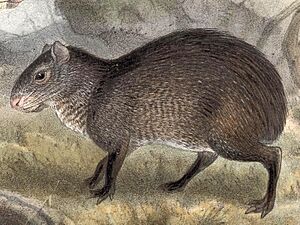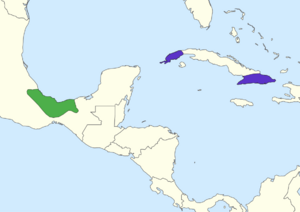Mexican agouti facts for kids
Quick facts for kids Mexican agouti |
|
|---|---|
 |
|
| Conservation status | |
| Scientific classification | |
 |
|
| Distribution range, green - native, blue - introduced |
The Mexican agouti (Dasyprocta mexicana), also known as the Mexican black agouti, is a type of rodent. It was first found in 1860 in Veracruz, Mexico. Henri Louis Frédéric de Saussure described this interesting animal.
Contents
Physical Description
The Mexican agouti is a medium-sized rodent. Adults usually weigh between 2 to 4 kilograms (about 4.4 to 8.8 pounds). Their body length, including a tiny tail, is about 40 to 60 centimeters (16 to 24 inches). The tail itself is only 2 to 3 centimeters long.
Their head and body are mostly covered in black or dark brown fur. You might see a few white hairs mixed in. The fur on their back and neck is longer and solid black. The fur on their belly, chin, and throat is lighter, mostly white. Around their eyes and ears, the skin looks pink.
Mexican agoutis have a rounded back and two pairs of thin, long legs. Their front legs have four strong, arched claws. These claws help them dig. Their back legs are much larger and have only three toes. These strong back legs help agoutis jump really well! It's hard to tell male and female agoutis apart just by looking at them.
Where They Live
The Mexican agouti lives on land and is native to Mexico. You can find them in the lowlands near the Gulf of Mexico. This includes areas like Veracruz, Oaxaca, Tabasco, and Chiapas. They have also been introduced to parts of Cuba, where they now live in the western and eastern regions.
Their Home
Mexican agoutis love to live in humid tropical rainforests. They also live in lowland evergreen forests and forests that are growing back after being cut down. They can live in places from 50 to 600 meters (about 164 to 1,968 feet) above sea level.
We don't know much about how Mexican agoutis use their home. But scientists think they might be similar to the Central American agouti. Central American agoutis often stay near fruit trees, which are important food sources. They also hide inside tree trunks for safety.
Reproduction and Life Cycle
Not much is known about how Mexican agoutis grow up. We do know that baby agoutis are born with fur and their eyes open. This means they are quite developed when they are born.
Female agoutis nurse their babies for up to 7 weeks. Even after they stop nursing, the young agoutis can stay in their mother's territory. From just one day old, baby agoutis can nurse, groom themselves, and look for food in leaf litter. They often follow their mother and eat the same foods she does. This helps them learn what to eat.
Mexican agoutis usually form pairs and mate for life. Each pair has its own territory, which is about 1 to 2 hectares (2.5 to 5 acres) big. The mother carries her babies inside her body, and the pregnancy lasts about 104 to 120 days. Agoutis usually have 1 or 2 babies during the dry season, which is from March to May.
In captivity, a Mexican agouti lived for over 13 years!
Behavior
Mexican agoutis are very quick and alert. They are always ready to run away from danger. Their behavior often changes depending on what's around them, like humans or other predators.
Normally, these agoutis are active during the day and at dawn/dusk. But if they feel threatened, especially by humans who hunt them, they can become active at night instead. This helps them stay safe and survive.
Communication and Senses
When a Mexican agouti senses danger, it makes sharp barking sounds through its nose. It also stomps its feet to warn other agoutis. Then, it runs away quickly.
What They Eat
Mexican agoutis mostly eat fruits, especially those with soft seeds. They also eat new plants that grow in the forest. They are known as "scatter-hoarding frugivores." This means they collect fruits and seeds, then bury them in different spots to save for later.
Other types of agoutis eat a lot of fruit. For example, the Red-rumped agouti eats about 87% fruit, 6% animal matter, and some leaves and fibrous foods. Mexican agoutis likely have a similar diet. They might eat things like citrus fruits, coconuts, avocados, mangoes, pineapples, and corn. They also eat leaves, flowers, roots, and even small insects if other food is scarce.
When they find food, agoutis often remove the fruit pulp and bury the seeds one by one. They dig small holes, about 2 to 8 centimeters deep, and cover the seeds with soil and leaves. They might dig these seeds up and eat them up to 8 months later! Pregnant agoutis eat more seeds to get extra protein, fat, and energy.
Agoutis have special teeth that help them eat different foods. Their front teeth (incisors) are always growing and are very sharp. They use their upper incisors to cut plants and pierce animal food. Their lower incisors help them cut and shear food.
Predators
Many animals hunt Mexican agoutis. These include cats, birds of prey, snakes, and jaguars. Sadly, humans also hunt them a lot.
To stay safe, agoutis hide in burrows or tree trunks when they are resting. If they meet a predator, they might freeze, make alarm calls to warn others, or raise the hairs on their rump to scare the predator away.
Helping Plants Grow
Agoutis have a special relationship with plants. They are very important for spreading seeds! When agoutis eat fruits and nuts, they get the nutrients they need. Then, they bury the seeds. This helps the seeds grow in good places. Agoutis also help spread seeds that other animals have eaten and passed in their poop. This helps plants reproduce and spread to new areas.
For example, agoutis are one of the few animals that can open the tough shell of a Brazil nut. Without agoutis, Brazil nut trees might not be able to grow as well.
Their Role in Nature
Mexican agoutis play a vital role in their ecosystem. They help spread seeds and are an important part of the food web.
By helping plants grow, agoutis make sure that other animals that eat those plants have enough food. Also, since many animals like birds, snakes, and wild carnivores eat agoutis, they are an important food source. If agoutis weren't there, these other animals would have to find new food, which could upset the balance of nature.
Importance to Humans
Mexican agoutis are important to humans for a few reasons. Their meat is a good source of protein and is eaten by many people in their home range. It's known for being tasty and healthy, with lots of calcium and phosphorus.
In some places, like Trinidad and Tobago, agouti meat is considered a special food. This has led to a lot of hunting. Agoutis have also been used for their skin, leather, and bristles.
Sometimes, agoutis can cause problems when they are introduced to new places. In the 1930s, Mexican agoutis were brought to Cuba. People worried they might compete with local animals for food. While they have spread in western Cuba, they don't seem to be causing big problems right now.
Conservation Status
The Mexican agouti is now considered a Critically Endangered species. This means there are very few of them left, and they are at a high risk of disappearing forever.
Their numbers are shrinking because their homes are being destroyed. Forests are being turned into farms and cities, leaving agoutis with fewer places to live. Also, a lot of hunting contributes to their decline.
Even though Mexican agoutis live in some protected areas in Mexico, more research is needed to figure out the best ways to protect them. Scientists need to learn more about how many there are, where they live, and how their populations are changing.


